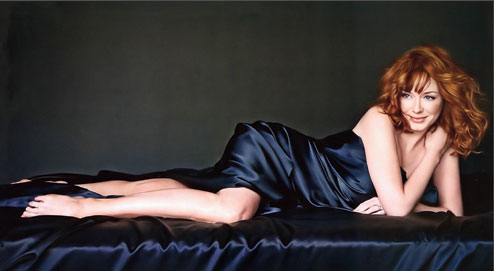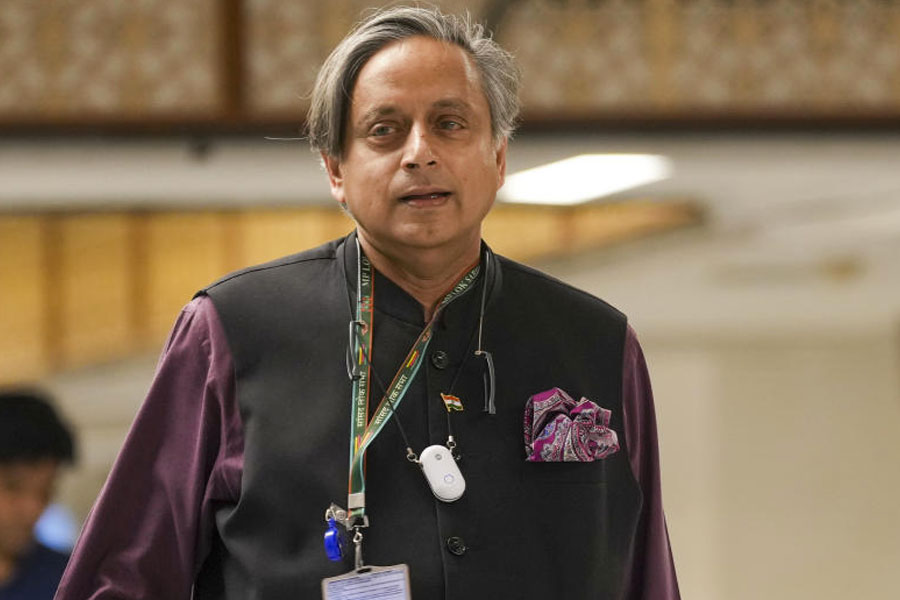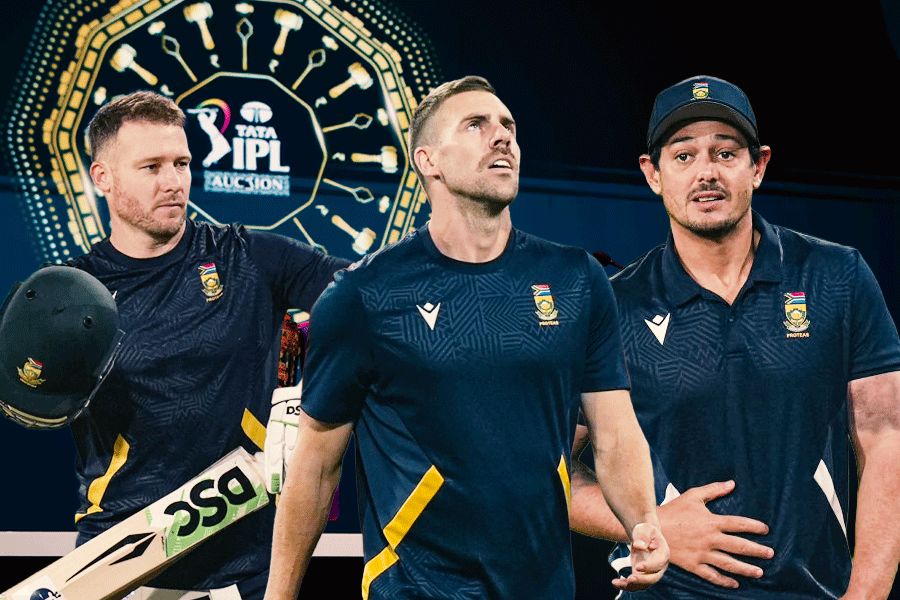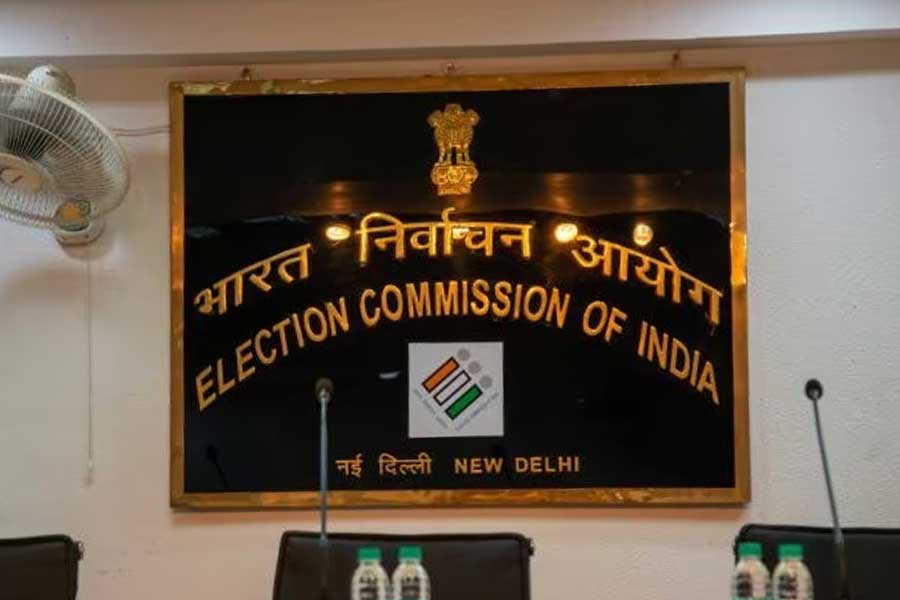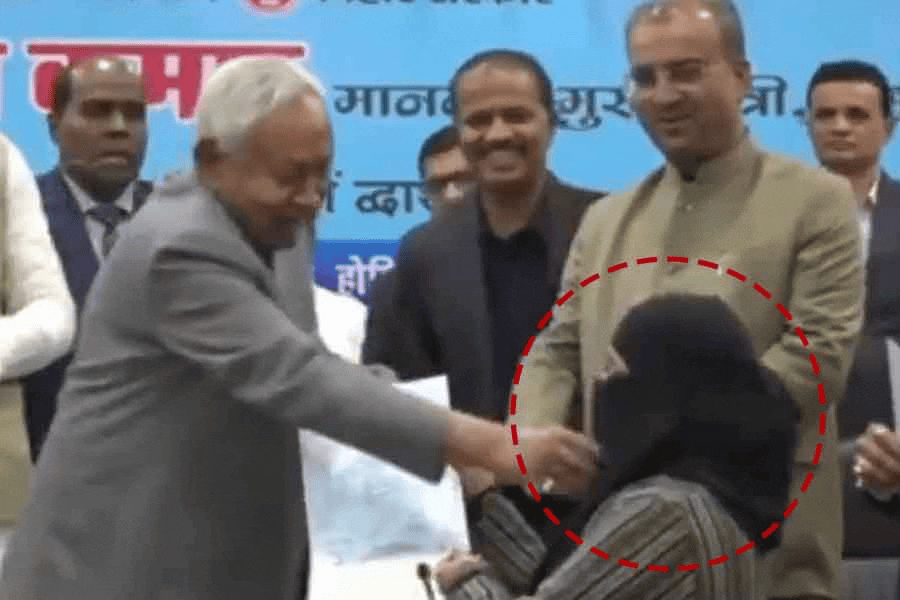
When I meet Christina Hendricks, she is spending the daylight hours heavily pregnant. She’s shooting a film called Egg in the suburbs north of New York City. A car arrives for her each day at 6am and she spends 12 or 13 hours strapped to a huge fake belly, waddling about the set or sitting as pregnant women do, one hand on her back. She has been getting dreadful lower back pains. “It’s awful being eight months pregnant,” she says.
The only time she can meet is at night after one of these marathon pregnancy sessions, and she suggests a bar near her apartment in Hell’s Kitchen. Waiting in what seems a rather dingy, frat-boy infested pub, I spot Hendricks pass by down the pavement and into the place next door. She’s very tall, that famous hair is brilliant red and she’s wearing a Forties-style navy dress with a tie at the neck. Even in this stylish bit of Manhattan it looks as if she has been superimposed on the landscape.
Two things immediately occur to me. First, I am embarrassingly underdressed. Second, and more importantly, I am in the wrong bar. The right place is a smart, white-tiled affair, with paper chandeliers and a manager who knows Hendricks well. He tells her he has a jacket of hers that she left in another one of his establishments; when our wine arrives the waiter tells us it is on the house.
We’re drinking on a school night, which seems louche in this New York of green smoothies, but appropriate given that almost no one can think about Hendricks for long without mentioning Mad Men, martinis and the figure of Joan Holloway, whom she played in the hit series between 2007 and 2015. When Hendricks first hove into view as Holloway in a pea green dress, her red hair done up, people lost their minds. It was as if they had never seen a woman before. You would not have been surprised if there had been questions in parliament.
However, tonight we’re discussing Tin Star, a ten-episode drama on Sky Atlantic that Hendricks, who is 42, shot last summer. It’s about a London copper and recovering alcoholic who emigrates with his family to Alberta to be the police chief in a tiny town called Little Big Bear. Tim Roth plays the cop and Hendricks plays a recovering journalist who now does PR for a shady oil mining corporation. It’s compelling stuff and slightly terrifying, but it looks gorgeous.
I’m incredibly open and talk about everything
The scenery — the whopping mountains and surging rivers — reminded Hendricks of her childhood. Her father was a Brit who joined the US military and became an American citizen. He was also a forestry worker and the family moved several times during her childhood. In her early years they lived among the artisans of Portland, Oregon, “people who kinda looked like my dad.... Like, with a fisherman’s cap on, beard, wireframe glasses. Like a bunch of old sailors wandering around.”
When they moved to southern Idaho her mother encouraged Hendricks and her older brother to join a local theatre. “She wanted us to make friends quickly,” she says. So many local kids joined up that when they did Grease, the director simply added new Pink Ladies to the cast and divided the lines among them.
“I was Donna,” she says. “You may not be familiar with the character. No one is, unless you saw the Twin Falls production in 1980-something.”
At least you got a leather jacket out of it, I say.
“No that’s the T-Birds. Silly you. You need to refresh your Grease.”
She describes her mother as an open-hearted romantic who “cries all the time” and occasionally must be shielded from Hendricks’s scarier films. Mum worked as a teacher, then trained as a therapist. “She would come home and sort of psychoanalyse us all. We’d be, like, rolling our eyes, like, ‘Not everyone’s obsessive-compulsive, Mum.’ But I do feel like it made me a pretty good fighter. Because my mum sort of made us talk things through.”
Hendricks looks uncertain. “My husband might disagree with that,” she says. “But I do think that... she helped us sort of manage some things, relationship-wise. I’m incredibly open and talk about everything.”
Her childhood in Idaho was blissful. “I had all these amazing friends through the theatre company,” she says. “And it was a community that really respected theatre. The kids would put on a play and the entire town would show. And you were cool if you were an actor.”
Then the family moved again to an urban patch of Virginia and Hendricks enrolled in high school, a rough place where there was far less appreciation for musical theatre. “It was a total shocker,” she says.
It left her so disenchanted with the idea of public education that she decided not to go to a local arts college, where she had a place to study theatre, but to head for New York instead and become a model. She had taken part in a contest to appear on the cover of Seventeen and although she didn’t win, someone thought the shots she had submitted of herself standing in a graveyard, in a wig and overcoat, showed promise. Her father was horrified. “He really wanted me to go to college,” she says.
Walking the streets of still gritty Manhattan was a shocker too. “People would say the foulest things to you,” she says. “I would walk with my head up and just, like, brimming with tears.”
I was the cute but nervous girl
However, she did well as a model and thinks of it now as an education in itself. She travelled widely and learnt what the rest of the world thought of America. “It was, ‘Oh, we’re d**ks,’” she says. “ ‘Everyone in England thinks we’re d**ks.’”
In her late 20s her mum called, asking if she fancied moving to California.

When Hendricks first hove into view as Joan Holloway (in Mad Men) in a pea green dress, her red hair done up, people lost their minds. It was as if they had never seen a woman before. You would not have been surprised if there had been questions in parliament. “I think one of the reasons people always want to be that character is because she is so powerful and strong, but super-feminine. People couldn’t imagine you could do that and still be feminine”

Her parents had separated, and Hendricks’s older brother was in Los Angeles (he does computer graphics for the TV network CBS). Hendricks thought she might model a bit to tide herself over, while trying to get a job in the music industry. “But in LA my modelling career took off.” She shot several national advertisements, including one with Pierce Brosnan. “For an actor it’s, like, ‘Oh no, I have to do a commercial.’ But for a model it’s the creme de la creme.”
Her brother worked next door to a Hollywood talent manager and regaled him with stories about his brilliant sister and how she had been really fantastic as the lead in a high school production of Agnes of God. “The manager was, like, ‘Ha ha. Everyone’s got a sister who’s a great actress.’ But he liked my brother so much, he was, like, ‘Have her come over, bring whatever film she has.’ So I brought over a reel of commercials. And he was, like, ‘I actually think I want to represent you.’”
The manager had only a few clients. One of them was Paul Rudd, another was Jon Hamm. At auditions people thought Hendricks might be a new Meg Ryan. She was seen as “this quirky, queer best friend”, she says. “I was the cute but nervous girl.” She shot a lot of pilot episodes that didn’t quite take off; if any of them had, she might quite easily have spent the rest of her life in rom-coms. “I never understood why I wasn’t getting that,” she says. “I was, like, ‘Guys? I’m hilarious.’”
Frequently people informed her that she was the wrong shape to play a police officer, or a doctor, or a lawyer. “I auditioned for things where I knew I killed the audition. I knew I did. It was, like, ‘Oh, should I give you my sizes now, or...?’ And they would call up and say, ‘We just don’t think that a doctor would look like that.’”
She looks at me over her wine glass. “I would be embarrassed to even say that out loud,” she says. “There should be a million different body types [on television]. It’s outrageous that there aren’t. And it’s outrageous that we’re sitting here having this conversation and it’s even a thing.”
She auditioned for Mad Men towards the end of “pilot season” and she remembers being exhausted. “I walk in there a little bit defeated. But I just put on my game face and did it. And I got this role. And ever since then I get all these, like, amazing, strong-assed powerful women,” she says.
“It took Matt’s [Weiner’s] beautiful writing to put me in the right place. I think one of the reasons people always want to be that character is because she is so powerful and strong, but super-feminine. People couldn’t imagine you could do that and still be feminine.”

I WAS LIKE, ‘This is bold!
This is bold!’
There was a delay before they started shooting the series, because Weiner was still writing for The Sopranos. He gave her a reading list that included the Sherwood Anderson short story collection Winesburg, Ohio, which seems a rather obscure choice, and Helen Gurley Brown’s opus Sex and the Single Girl, which does not. Hendricks found insights on Holloway on nearly every page. “Things like, ‘Always have candy on your desk so that a man will have a reason to come over and linger along at your desk,’” she says. “‘When you sit down, lift your skirt just an inch so that the slip shows, just to tantalise a little bit. Give them something to look at.’ I was, like, ‘This is bold! This is bold!’”
Joan Holloway was so close to that spirit. “Listen, don’t take this the wrong way,” she tells Peggy Olson, the new recruit, in the pilot episode of Mad Men. “But a girl like you, with those darling little ankles — I’d find a way to make ’em sing.”
They were well into the first season when Hendricks had a troubling thought. “I’m, like, ‘Joan is a bitch,’ “ she says. “And I don’t remember how not to judge her.” She was dismayed to see her disparaging a colleague for having a black girlfriend. “I rang Matt and said, ‘So now Joan’s just racist?’ And he was, like, ‘Calm down.’ And he said, and this is what I use forever more, ‘Joan thinks she’s helping.’”
What of the delirium over her figure? “Fashion had gotten very sloppy,” she replies. “People were going out in what seemed like clothes you would be humiliated to be caught in. Like, that’s what I wear when I have the flu and I’m shuffling from my couch to the fridge. People were out on the streets wearing this clothing. And all of a sudden we came along... wearing super-tailored, beautiful clothes that we hadn’t seen a while. That really accentuated our figures.”
The focus was very much on Hendricks, though. It was as if she had reinvented what it meant to be beautiful. I can’t think of a man who has had the same effect.
“Well,” says Hendricks. “What about someone like....?”
She names an actor, but asks that I not repeat it. Possibly she’s worried that he will start hanging around outside her apartment. I must say that if he has reinvented beauty he must have done it while I wasn’t looking.
Hendricks mounts a spirited argument about how this fellow doesn’t conform to standard ideas of comeliness, which is certainly true. The conversation reminds me of a time when I saw a friend — a tough, clever journalist — looking at a photograph of Russell Brand and being overcome with desire. I couldn’t hope to understand.
Hendricks says she is not into Brand at all. She appeared next to him once, on a late-night talk show. “He was very inappropriate.” He made a joke about her knitting, she says.
Wait a moment. You knit?
“I do!” She pulls out her phone and shows me a photograph of her cockapoo sitting on a bed, wearing a Fair Isle patterned sweater she made. The dog is actually a celebrity in her own right, Hendricks says. “She’s been in Brooks Brothers ads. She’s been in People magazine. It’s real.”
If only I had known. I would have started with the dog.
She’s called Zuzu, after a character in the film It’s a Wonderful Life. “We got her at Christmas time,” she says. “We’re huge fans of that film. My husband can do a fantastic Jimmy Stewart impersonation.”
Well, I can totally understand the appeal of that. If I had to marry a man, I hope he would sound like Stewart. Definitely not Brand or the other fellow. “My husband is basically Jimmy Stewart,” she says.
Her husband is the actor Geoffrey Arend. “We’ll celebrate eight years of marriage in October,” she says. “We’ve been together almost 10. Does not feel that long at all. I just know him so well now. I’ve never known anyone that well in my life.... He understands me and he listens to my crap and still somehow loves me and I’m so grateful for that.”
We’re the people who don’t have kids
They’re not planning to have children. She said this recently and it caused a sensation. “And then there were a lot of people who came and thanked me for saying it out loud. And I thought, ‘Well, isn’t that sad, that we can’t say it out loud?’ I really don’t understand the hullaballoo around it. There’s people who have kids and people who don’t have kids. We’re the people who don’t have kids.”
It was like the stuff about her figure. “One day when aliens come down from another planet, they will think we were all starving to death because all they found were movies,” she says. We’re well into our second glass of wine by now, our little table glasses and a cheese board, and I’m struggling to follow her.
“If we all died from global warming and all the aliens found were movies,” she says, by way of explanation.
Oh, I get it. The little green men, trying to reconstruct what happened to the human race, stumble on a Hollywood vault and watch shows from the late 20th and early 21st centuries. Everyone’s painfully thin.
“So they think, ‘This is what human beings looked like,’” she says. “They’ll think we all starved to death.”
And this becomes the accepted theory for the decline and fall of the human race, among the alien historians. And then, I imagine, they see Hendricks playing Joan Holloway in Mad Men and it blows their minds. As it did ours.
Will Pavia
(The Times, London)

